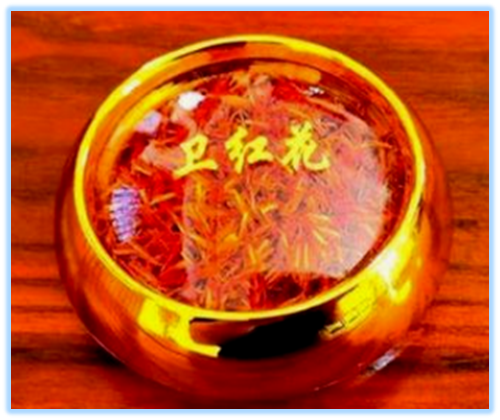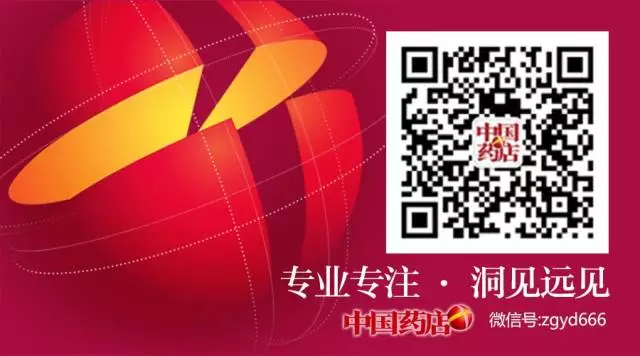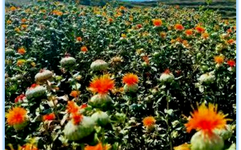
The application and cultivation history of Honghua (Safflower) is long-standing. According to the “Compendium of Materia Medica” (Bencao Gangmu), the blue flower is also known as safflower, and its leaves resemble those of orchids, hence the name. It grows in the Lianghan region and the Western Regions. The “Records of the Great Historian” states that Zhang Qian obtained seeds from the Western Regions, and it is now also cultivated in Wei territory. Historically, during the Three Kingdoms period, Jixian belonged to Wei territory, and in the Ming Dynasty, Jixian was renamed Weihuifu. At that time, the safflower from Wei was renowned alongside cotton from Zhangde Prefecture and chrysanthemums from Huaqing Prefecture. The Qing Dynasty’s “Jixian Gazetteer” records: “During the Xian and Tong years, many people cultivated safflower, and by the tenth year of the Republic of China, it was sold for one yuan per pound, though prices were not always stable. From the Qing Dynasty to the Republic of China, Wei safflower was already exported to Southeast Asia and various countries in Western Europe.
The safflower produced in Weihuishi during the Republic of China is a genuine medicinal material. Weihuishi has a long history of safflower cultivation. It is renowned nationwide for its unique characteristics of high yield, excellent quality, long red filaments, oily texture, and strong medicinal aroma, earning it the honor of a geographical indication product.

Safflower, also known as Honghua, is now found everywhere. It is commonly cultivated in gardens, sown in winter on prepared land, and seedlings emerge in spring, blooming in summer. The flower heads are spiny, with the filaments protruding from the heads. Gardeners collect them by hand, and after harvesting, they regrow until the end of the season. The seeds are white, about the size of small beans. The flowers are dried to produce a true red dye and are used to make rouge. It is primarily used for postpartum blood disorders. The leaves resemble those of blue flowers, hence the name.
Honghua originally comes from Egypt and was introduced to China during the Han Dynasty, boasting a cultivation history of over 2000 years. This product is the dried flower of the Asteraceae plant, safflower. The flowers are harvested in summer when they change from yellow to red, ensuring not to damage the base ovary, removing impurities, and drying in the shade or with low heat. At this time, the quality is softer, and the best color is deep red.
Safflower blooms from late May to mid to late June, with peak flowering occurring in late May to mid-June, and is harvested in batches. It is best to pick on sunny days, between 6-8 AM, when the tubular flowers are fully opened and golden yellow. If harvested too late, the flowers wilt and turn red-black, making them difficult to collect, resulting in poor quality and low yield. After harvesting, they should be dried in the shade or at low temperatures of 40-60°C. When collecting flowers, it is advisable to do so before the morning dew has dried and when the bracts are soft.
Safflower from Sichuan is commonly referred to as Chuan Honghua, while that from Henan is called Huai Honghua, and the one from Xinjiang is known as Xinjiang Honghua.

This product is pungent, warm in nature, and enters the heart and liver meridians. It is effective in invigorating blood circulation, regulating menstruation, dispersing blood stasis, and alleviating pain. It is primarily used for amenorrhea, dysmenorrhea, retained lochia, abdominal masses, traumatic injuries, and painful sores. Safflower is red and warm, affecting both the heart and liver, with a sweet, bitter, and pungent flavor, which can invigorate blood vessels, eliminate stasis, and promote new blood generation. It is used for treating injuries before and after childbirth, and can break blood stasis, promote blood flow, harmonize blood, and regulate blood.
Clinically, the dosage varies. It is effective in promoting meridian circulation as a blood and qi herb; different dosages can either drain or tonify. Three to four qian (a traditional Chinese weight unit) may be too pungent and warm, causing blood to disperse. It can be combined with Su Mu to disperse blood stasis, and with Rou Gui to regulate menstruation, or with Gui Zhi and Bai Shao to treat systemic or chest and abdominal blood stasis pain, which promotes circulation and invigorates blood. If taken in seven to eight fen (another traditional weight unit), it can soothe liver qi to assist blood sea, greatly tonifying blood deficiency, which harmonizes and regulates blood; if taken in two to three fen, it can enter the heart to nourish heart blood, dispelling heart fire, thus harmonizing blood. However, excessive dosage can lead to uncontrolled bleeding.
Safflower is a key herb for invigorating blood. It is primarily used for postpartum blood stasis and fainting, as the retained blood does not descend and reverses to the heart, causing fainting and locked jaws. By entering the heart and liver, it facilitates the downward movement of retained blood, thus stopping fainting and locked jaws. Abdominal cramping pain is due to retained blood not being expelled; if the fetus dies in utero, it will not descend without invigorating blood. Therefore, blood stasis must be resolved for pain relief and to expel the dead fetus. Safflower is fundamentally a blood-invigorating herb; it resolves blood stasis and promotes circulation, stopping pain. However, excessive use can lead to uncontrolled bleeding.

This product is pungent, warm, and effective in invigorating blood, resolving stasis, and alleviating pain. It is commonly used in obstetrics and gynecology for blood stasis abdominal pain. It can be decocted alone or combined with Dang Gui, Chi Shao, and Tao Ren. It can be said: “For all symptoms during labor, safflower is indispensable; for all symptoms postpartum, safflower is essential; for all symptoms of qi and blood disharmony, safflower is crucial.”
Additionally, safflower promotes menstruation and resolves stasis, effectively clearing blood vessels and alleviating swelling and pain. It is often used for various traumatic injuries, chest obstruction, and heart pain, commonly combined with Dan Shen and Gui Zhi. For sores and abscesses, it is used in conjunction with heat-clearing herbs.
This product consists of dried tubular flowers, approximately 1.5 cm long, orange-red in color, with narrow tubular flowers that split into five lobes at the tip. The lobes are narrow and linear, measuring 5-7 mm in length, with five stamens and yellow anthers fused into a tube, protruding beyond the lobes, with a central stigma exposed. It has a distinctive aroma and a slightly bitter taste.

Safflower is a commonly used traditional Chinese medicinal material in China. Currently, Xinjiang safflower accounts for over 75% of the national production, followed by Yunnan and Gansu. The market is divided into Xinjiang and Yunnan products, with Yunnan harvested in spring and Xinjiang in summer, with a six-month gap between harvests. The quality of Xinjiang safflower is generally better than that of Yunnan. When harvesting, safflower should be selected when it is fully red, as this enhances its medicinal properties; orange-yellow flowers should be harvested again.
For the best quality, choose flowers that are long, red-yellow, bright, soft, and thornless, and store them in a dry, sealed container in a cool, dry place to prevent moisture and pests. Dyed safflower can be faked using dyes such as Golden Orange II, Sunset Yellow, Lemon Yellow, and Carmine Red. Generally, safflower dissolved in clear water yields a golden or orange-yellow solution, while the safflower itself does not fade. Counterfeit products produce a murky brown-red solution with sediment at the bottom of the cup, and the flower color will fade.

This article is an original/compiled work by China Pharmacy.
Reproduction without permission is prohibited.

Long press the image above for 3 seconds to scan the QR code and follow us.
Dear reader, the China Pharmacy public account is continuously collecting articles. If you wish to express your thoughts, document your life, or share experiences, you can send your works in text or image format to [email protected] (email). Payment = 200 yuan + reading volume * 0.01 yuan. Please indicate your contact information when submitting.
Let others know you are “watching” ↘

